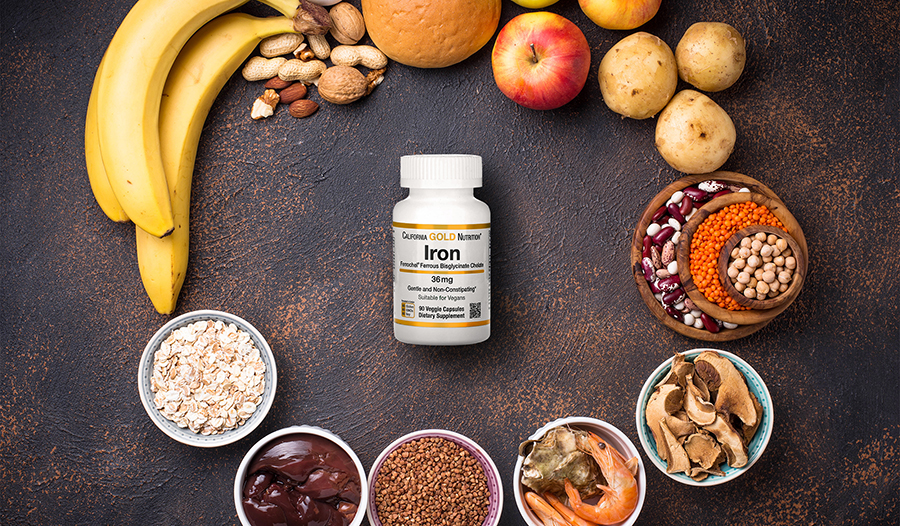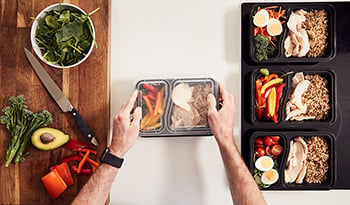Топ 3 храни с високо съдържание на желязо и признаци, че може би се нуждаете от повече в диетата си

Желязото е основен компонент на хемоглобина, който е част от червените кръвни клетки. Недостигът на желязо е най-често срещан при жени в детеродна възраст (особено при тези с обилно менструално кървене), но е важно да се изключи и при малки деца, хора с храносмилателни разстройства или възпалителни състояния, хора, които не ядат месо, хора, които участват в редовни интензивни физически тренировки, хора, които често даряват кръв, хора с анамнеза за операция на храносмилателния тракт, например стомашен байпас, и всички, чиито симптоми могат да насочат към недостиг на желязо.
Желязото е необходимо за производството на червени кръвни клетки, хормон на щитовидната жлеза, допамин и оптимална имунна функция. Особено важно е децата и бременните жени да приемат достатъчно количество желязо, тъй като ниските му нива могат да допринесат за забавяне на развитието, неадекватен растеж, поведенчески проблеми и преждевременно раждане. Често добавките могат да решат проблема с дефицита, но понякога той може да е признак на сериозно основно заболяване. Поради това доставчиците на здравни услуги трябва да направят изследване, за да изключат сериозни заболявания.
По-дългосрочният недостиг на желязо може да доведе до желязодефицитна анемия, когато нивата на червените кръвни клетки са ниски. Червените кръвни телца са от решаващо значение за доставянето на кислород и хранителни вещества в цялото тяло. Други видове анемия се причиняват от недостиг на мед. , витамин В12, и фолат. .
Симптомите на недостиг на желязо и анемия могат да включват умора, ниска енергия, задух, болки в гърдите, менструални проблеми, неспокойни крака, мускулни болки, затруднено внимание, косопад, ниско съдържание на стомашни киселини, непоносимост към студ и лошо настроение.
Посъветвайте се с лекаря си за кръвен тест за нивото на желязо, за да проверите дали имате недостиг на желязо. Феритинът, протеин, който пренася желязото в кръвта, е един от най-често използваните тестове. Това е отделен тест от скрининга за анемия, пълната кръвна картина (ПКК) или хематокрита. Прекалено многото желязо е токсично; уверете се, че сте правилно диагностицирани с ниско съдържание на желязо, преди да приемате добавка.
Видове желязо
В храната се съдържат два вида желязо - хемно и нехемно. Типичният прием на желязо от всеядни хора е около 10-15% хемово желязо, но общото количество, което се абсорбира, е 40% хемово желязо, което показва много по-голямата полезност на хемовото желязо.
Нехемовото желязо е видът, който се получава от растенията; то може да се абсорбира трудно в червата. Степента на усвояване варира в зависимост от текущите запаси и индивидуалните фактори на човека.
Хемното желязо използва специален транспортер, за да стигне от червата до клетките, където е необходимо. За разлика от него нехемовото желязо често е свързано с други съединения, които затрудняват пренасянето му до мястото, където тялото го използва.
Топ 3 на хранителните източници на желязо
Въпреки че редица храни съдържат желязо, ето трите най-добри варианта за получаване на желязо от храната.
1. Меласа
Меласата- страничен продукт от преработката на захарна тръстика - е необичайна съставка с необичайно висока бионаличност на желязото. Черната меласа съдържа 2,3 mg желязо на супена лъжица и 50%-97% от него се абсорбира. Използвайте го в рецептите си за меденки, печен боб, топли напитки или глазури за месо и зеленчуци.
2. Месо
Месото е най-доброто място за получаване на най-усвояемата форма на хемово желязо. Най-големи източници са червеното месо, като говеждо и агнешко, но птиците и морските дарове също са добри източници, особено стридите. Около 15-35% от хемовото желязо от животинските продукти се абсорбира в червата ни.
3. Желязо на растителна основа
Растителните източници на желязо включват леща, боб, спанак, ядки, шоколад, както и обогатени зърнени и житни култури. Количеството желязо, което се съдържа в тези храни, и количеството желязо, което може да се използва в организма ни, не са еднакви, тъй като растителните храни съдържат съединения, известни като фитати и полифеноли, които възпрепятстват усвояването на желязото в червата.
Само 2-20% от нехемалното желязо на растителна основа се използва от организма ни. Според някои източници биологично отглежданите култури съдържат повече желязо, отколкото конвенционалните. Ако спазвате диета без или с ниско съдържание на месни продукти, посъветвайте се с лекаря си за кръвен тест за желязо, за да се уверите, че нивата на желязо в кръвта ви са достатъчни.
Други начини за подобряване на усвояването на желязото
За да увеличите съдържанието на желязо в храната, можете да готвите с чугунен тиган. Храната ще абсорбира малко количество желязо от тигана. С течение на времето това може да се увеличи достатъчно, за да се поддържат адекватни нива.
витамин C
Добре известно е, че витамин С повишава абсорбцията на нехемовото желязо в червата. Приемането на добавка с витамин С или консумирането на богати на витамин С храни едновременно с добавките с желязо може да повиши ефективността.
Калций
Калцият има противоречиви изследвания за потискане на абсорбцията на желязо. Според някои проучвания той предотвратява абсорбцията, а според други - не. Вероятно е най-добре да се избягва приемането на калциеви добавки едновременно с добавки с желязо, за да се гарантира ефективност, докато не се изясни това потенциално взаимодействие.
Цинк
Цинкът е друг важен хранителен елемент, който пречи на усвояването на нехемовото желязо. Ако е необходимо дългосрочно приемане на добавки с желязо, приемът на добавка с цинк по различно време на деня може да бъде полезен за поддържане на цялостно адекватно хранене.
Витамин Е
Витамин Е може да попречи на усвояването на желязото. Поради това недостигът на витамин Е може да засили страничните ефекти на добавките с желязо, а проучванията върху животни показват, че добавките с витамин Е могат да сведат до минимум неблагоприятните ефекти на добавките с желязо.
Кафе, чай, соя
Кафе, черен чай, и соевите продукти могат да потиснат усвояването на желязото в червата. Ако имате нужда от добавки с желязо, може да е полезно да ги приемате по различно време от това, когато ги консумирате.
Странични ефекти на добавките с желязо
Различните видове препарати за добавяне на желязо имат различна степен на странични ефекти. Най-честите странични ефекти обаче включват запек, храносмилателен дискомфорт и гадене. Приемането на хранителни добавки с храна често ограничава тези ефекти, но се консултирайте с Вашия лекар за най-подходящата за Вас форма на желязо.
Кой не трябва да приема желязо?
Добавките с желязо са полезни за тези, които се нуждаят от тях, но няколко групи хора никога не трябва да приемат добавки с желязо. Хората с генетични нарушения на кръвта или черния дроб, като таласемия или хемохроматоза, са склонни да натрупват повече желязо от останалите хора, затова трябва да разчитат само на храната.
Хората, които имат адекватни нива на желязо, не трябва да приемат добавки, а просто да разчитат на приема на храна, за да поддържат адекватността. Излишъкът на желязо увеличава оксидативния стрес, което може да влоши възпалителните заболявания и други състояния.
Добавката с желязо може да повлияе на някои лекарства. Посъветвайте се с Вашия лекар дали е необходимо да приемате добавката си по различно време на деня, освен лекарствата си.
Случайното поглъщане на добавки с желязо при малки деца е един от най-често срещаните видове отравяния. Това може да доведе до сериозни нежелани събития, включително смърт. Съхранявайте добавките с желязо на недостъпно за малки деца място и не им ги давайте без диагноза за недостиг от квалифициран медицински специалист.
Вземане на храна
Желязото е основно хранително вещество и неговият недостиг е често срещан в целия свят. Симптомите на недостиг могат да бъдат неспецифични за ниско съдържание на желязо и да представляват друг проблем. Посъветвайте се с лекаря си да ви направи подходящ кръвен тест, за да разбере дали трябва да приемате добавка. Консумирайте разнообразна диета с месо, пълнозърнести храни, плодове и зеленчуци за цялостно добро здраве, като при необходимост добавяте добавки с подкрепата на вашия доставчик на здравни услуги.
Препратки:
- Габи А. Хранителна медицина. Конкорд, Ню Йорк: Fritz Perlberg Publishing; 2011.
- Jain R, Venkatasubramanian P. Меласата от захарна тръстика - потенциална хранителна добавка при лечението на желязодефицитна анемия. J Diet Suppl. 2017;14(5):589-598. doi:10.1080/19390211.2016.1269145
- Служба за хранителни добавки - желязо. NIH Office of Dietary Supplements. https://ods.od.nih.gov/factsheets/Iron-HealthProfessional/. Публикувано на 2 март 2018 г. Достъпен на 13 декември 2021 г.
- Young I, Parker H, Rangan A, et al. Връзка между приема на хем и нехем желязо и серумния феритин при здрави млади жени. Хранителни вещества. 2018;10(1):81. doi:10.3390/nu10010081
ОТКАЗ ОТ ОТГОВОРНОСТ:Този УЕЛНЕС ХЪБ няма за цел да поставя диагнози...














































































 Съдържание
Съдържание
















